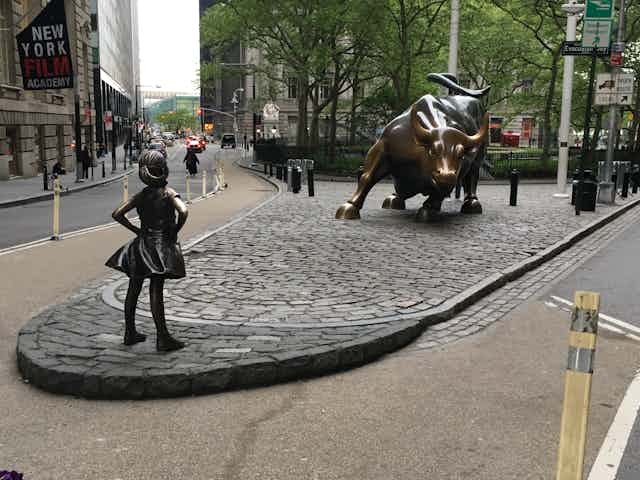Kristen Visbal’s 250lb “fearless girl” sculpture recently won three Grand Prix and 18 Lions in all, making her the biggest winner in the history of the Cannes Lion International Festival of Creativity. The awards and accolades have credited her with challenging gender equality on Wall Street – despite her own use of gender stereotypes and the fact that the statue was commissioned by the very financial institutions the piece purports to challenge.
The statue, which was placed in front of Arturo Di Modica’s iconic “charging bull” – a minimalist three-and-a-half ton bronze sculpted bull that marks New York’s financial district – on International Women’s Day, has been at the centre of debates ever since. Their juxtaposition has spurred discussion about workplace gender equality as well as art that mostly ignore the political economy of the surrounding financial institutions that directly and indirectly brought them together.
The newcomer was enthusiastically embraced and commentators see her as challenging Wall Street’s gender gap salary ceiling, implying that the bull is a symbol of patriarchy and capitalism gone wild – antagonist toward female leadership in business, reflecting patriarchy and capitalism gone wild. The tensions between these pieces became exacerbated when Di Modica claimed that the placement of the girl violates his rights as an artist because of its deliberate positioning and intended alteration of the context of his work.
DiModica placed his bull in front of the New York Stock Exchange while New York slept in the early hours of December 15, 1989. It was not a simple act: the bronze bull cost him US$350,000 to build – which he financed by selling his family property in Sicily. With the help of friends, a truck and crane, Di Modica seized an eight-minute gap in the NYSE police patrol routine to install the sculpture. But the NYSE officially rejected the bull, leaving Di Modica to pay relocation costs to its present location in Bowling Green with the blessing of former mayor Ed Koch. The rest is history, as Arturo’s gift to NYC has allegedly become the most photographed art object in the city.
The fearless girl was also placed at night and many commentators, including Visbal, responded to Di Modica’s complaint as a questioning of their right to guerrilla art. But he isn’t – rather it is the contrived tailcoat-riding reinterpretation of the meaning of his bull, rendering it immediately sexist and destructive and creating one artistic statement out of two statues, that is DiModica’s overall gripe.
One needs to only quickly survey the newspapers and social media sites to confirm that the bull has been appropriated in ways that cast it in a negative light. In online forums, several posts expressed their views that both the bull and its artist are macho capitalist pigs implying that the bull opposes “her”.
Branding exercise
But the creation of the Fearless Girl was orchestrated by a financial institution that is emblematic of the type of power structures that impede such an emancipation. The piece was commissioned from McCann advertising agency by State Street Global Advisors, a firm managing US$2.4 trillion in assets, as a means of positive publicity. State Street was aiming to rehabilitate its brand image, particularly in a climate of past allegations of misconduct and as a turnaround celebration of its SPDR Gender Diversity Index, which trades under the symbol SHE.
Indeed, the fearless girl’s plaque (now removed) reads: “Know the power of women in leadership. SHE makes a difference.” Here, the symbol of feminism is simultaneously a ticker-tape symbol, much to the annoyance equality advocates who see this as “corporate feminism”, a thrust toward an elitism that maintains inequality an genuine lack of options for all women and men.
Sympathisers of the fearless girl, in attacking Di Modica, state that the interpretation of art is independent from the intentions of its artists – which is true enough. Yet their interpretations align with Visbal who aesthetically used the placement in front of the bull “to illustrate the magnitude of what woman are up against in the workplace” – hence implying the preconceived negative intentions toward the interpretation of the bull.
Gendered art
As noted on an anthropology blog, in the graffiti world tagging close to or in conversation with a masterwork is a sign of disrespect and an audacious declaration of war – as well as a cheap attention-grabbing ploy. Even the boldest museum curators do not place confrontational objects before masterpieces.
Equally objectionable is how the juxtaposition of the girl and the bull restate conservative gender images. This deliberate casting of outdated conventional gender stereotypes – the brave little girl vs the big bad male bull – is belittling. Gender discrimination and the corporate sidelining of women assume more nuanced and insidious forms, which such simplistic images obscure. Might not women and girls be the bull or charging alongside it?
The bull remains poised while SHE, a symbol of the disneyfication of feminism, catalyses anger toward the bull and its artist rather than toward the structures of inequality that permeate financial institutions and those they affect. The “face off” is not between a fearless girl and a raging bull but rather between feminist posing and person-power, between corporate and guerrilla art and between complicity and defiance. In this sense the “face off” should be between the girl and a mirror.

